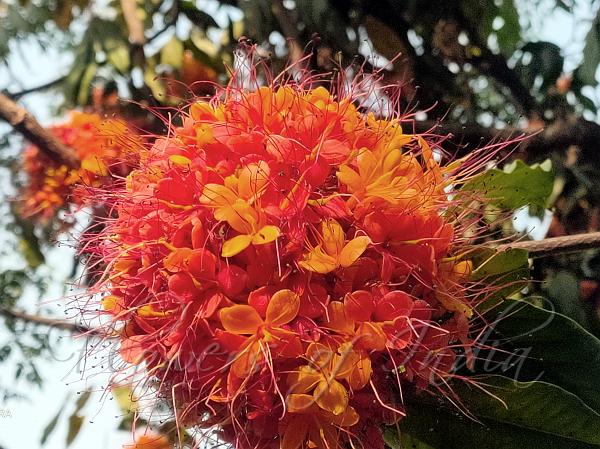|
| Sita Ashok |
|

|

| File size | 907242 |
| Original date | 3/23/21 8:02 AM |
| Resolution | 0 x 0 |
| Flash | Flash did not fire, auto |
| Focal length | 4.73mm |
| Exposure time | 1/956s |
| Aperture | 1.8 |
| Focus Distance | |
| Metering Mode | Unknown |
| Camera make | realme |
| Camera model | realme 5 Pro |
| Sensor type | Undefined |
|
|
|
Photo: |
Botanical name: Saraca asoca Family: Caesalpiniaceae (Gulmohar family)
Synonyms: Jonesia asoka
Synonyms: Jonesia asoka
Ashoka is one of the most legendary and sacred trees of India, and one of the
most fascinating flowers in the Indian range of flower essences. Ashok is a
Sanskrit word meaning without grief or that which gives no grief.
Indigenous to India, Burma and Malaya, it is an erect tree, small and
evergreen, with a smooth, grey-brown bark. The crown is compact and shapely.
Flowers are usually to be seen throughout the year, but it is in January and
February that the profusion of orange and scarlet clusters turns the tree into
an object of startling beauty. Pinned closely on to every branch and twig,
these clusters consist of numerous, small, long-tubed flowers which open out
into four oval lobes. Yellow when young, they become orange then crimson with
age and from the effect of the sun's rays. From a ring at the top of each tube
spread several long, half-white, half-crimson, stamens which give an hairy
appearance to the flower clusters. In strong contrast to these fiery blooms is
the deep-green, shiny foliage. The foot-long leaves each have four, five or
six pairs of long, wavy-edged, leaflets. Young leaves are soft, red and limp
and remain pendent even after attaining full size.
Medicinal uses: As one would expect from a tree of the country it
has many useful medicinal properties. The juice obtained from boiling the bark
is a cure for some ailments of women, and a pulp of the blossoms is one of the
remedies used for dysentery.
As one would expect from a tree of the country it
has many useful medicinal properties. The juice obtained from boiling the bark
is a cure for some ailments of women, and a pulp of the blossoms is one of the
remedies used for dysentery.
Medicinal uses:
 As one would expect from a tree of the country it
has many useful medicinal properties. The juice obtained from boiling the bark
is a cure for some ailments of women, and a pulp of the blossoms is one of the
remedies used for dysentery.
As one would expect from a tree of the country it
has many useful medicinal properties. The juice obtained from boiling the bark
is a cure for some ailments of women, and a pulp of the blossoms is one of the
remedies used for dysentery. | Identification credit: Neelima Kale | Photographs from Manipur & Maharashtra. |
• Is this flower misidentified? If yes,